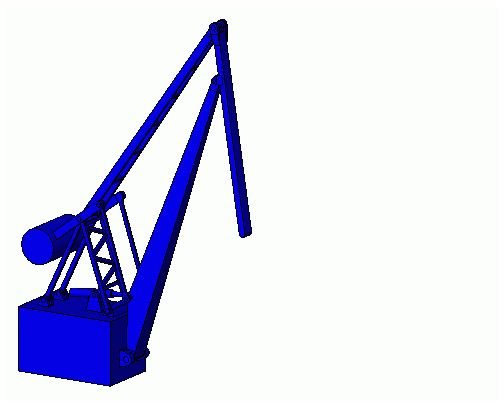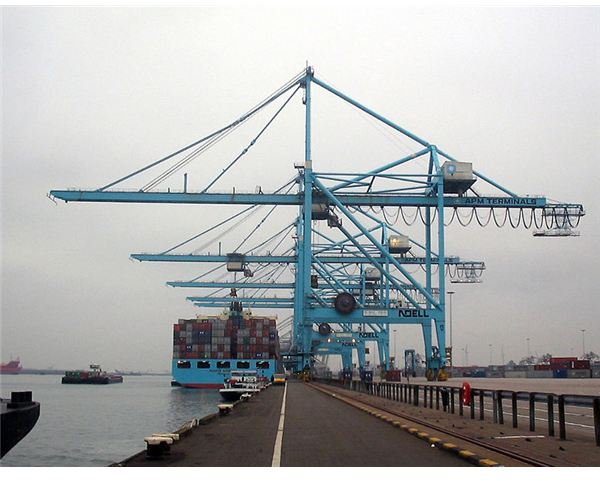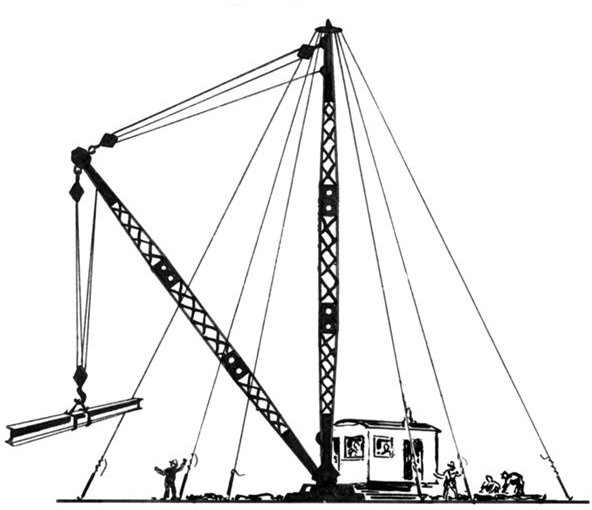Types of Shipboard Cranes
Introduction:
The duty of winches and cranes is to lift and lower the load by means of fixed wire ropes or wrap pins to lower or higher positions by derricks. All cranes should be able to perform the following functions:
- Lift the load at a suitable speed.
- Hold the load from running back.
- Lower the load under control.
- Take up the slack on the slugs without induced stress.
- Drop the load smartly on the hold.
- Allow more power when overloaded on starting up again and automatically lower the power when the load is relieved.
- Have good acceleration and retardation.
In addition to these, when the crane is electrically driven, the following requirements should be satisfied:
- Prevent any over speed which will damage the motor armature.
- Stop the load from running back if the power fails.
- Prevent the winch starting again when the power is restricted until the controller has put back to the correct position.
Cranes are basically classified by their method of working:
- Cargo Winches or Derricks
- Jib Cranes
- Gantry Cranes
1. Cargo Winches or Derricks
Cargo winches are used with the various derrick systems arranged for cargo handling. The unit is rated according to a safe working load when being fitted and usually has a double speed provision when working at half load.
In a cargo winch, a spur reduction gearing transfers the motor drive to the barrel shaft. A warp end may be fitted for operating the derrick toppings lifts (the wire which adjusts the derrick height). Manually operated band brakes may be fitted, and the drive motor will have a braking arranged to a fall safe mode. That is it will hold the load if power fails or the machinery is stopped.
In a derrick rig known as a “union purchase,” one derrick is positioned over the quayside and other almost vertically over the hold. Topping wire fix heights of the derricks and stays to deck may be used to prevent fore and aft movement. Cargo handling wires run from two winches and join the hook. A combination of movements from the two winches enables lifting, transferring, and lowering of cargo. This is only one of several possible derrick arrangements or rigs. Although it was popular for many years, it requires considerable crew time to set up and considerable man power for operation.
2. Jib Cranes
Cranes have replaced derricks on many modern ships. Positioned between the holds on platforms which can be rotated through 360 degrees, deck cranes provide an immediately operational unit requiring only one man to operate it. Double gearing is a feature of most designs, providing a higher speed at lighter loads. Various types of cranes exist for particular duties, for example, a general duties crane uses a hook and a grabbing crane is for use with bulk cargoes.
A general cargo crane has three separate drives that provide the principal movements:
- A hoisting motor for lifting the load.
- A luffing motor for raising or lowering the jib.
- A slewing motor for rotating the crane.
Luffing
In the movement of jib up and down, the limit switch works when:
- Jib is limited to certain angle of inclination.
- The movement of the jib above this limit is prevented by luffing limit switch; this stops the motor and luffing drum.
Hoisting
The up and down movement of the hook from the jib by means of running wire; the hoisting limit switch works when:
- It is mainly provided to avoid the damage occurred to the base plate fitted on the cargo hold where the hook lands during a heaving up operation.
- The hoisting motor will stop at a distance before the hook block touches the base plate.
Slewing
The rotation movement of whole crane through 360o with all the machinery; the aft most crane near to the accommodation can be rotated only 180o and it is provided with a slewing limit switch.
Slack wire limit
If the operators by mistake pay more wire rope, which is lowering, the wire gets slack. Then the slack wire limit switches activate and stop the hoisting operation by stopping the hoisting motor and drum.
This is to avoid winding of the wire irregular in the drum while heaving and causes damage to the drum, supporting brackets, and other parts related to the hoisting. The operator’s cab is designed to provide a clear view of all cargo working areas so that the crane operator can function alone.
Using Two Cranes Together
The crane is usually mounted on the pedestal to offer adequate visibility to the operators. For occasional heavy loads arrangements, two cranes are made to work together, i.e. twinning. This can be done with a single operator using a master and slave control system in the two cranes. A common revolving platform will be necessary for this arrangement. The operating medium for deck crane motors may be hydraulic or electrically operated.

3. Gantry Cranes
Gantry provide a base for the ship board cranes, each gantry is of open steel construction consist of an horizontal span supported on two pair of legs. The gantry straddles the ship’s holds each pair of legs resting on rails switch run the length of the deck to port and starboard at the hatch cover.
The gantry is equipped with extension (wings or arm) of each end of the horizontal span. When extended telescopically, they project over the ship sides. A top platform with cabins beneath is situated on a bogie and able to travel the length of the span. Also on the platform is the winch with four hoist wires on grooved barrels, each driven by an electrical motor. The wires have at their lower ends the lifting head which can be used with a grab or hook. The operator can raise or lower the load and can rotate it in some cases through 360 degrees. He can move the load by moving cables along the span and can move the load fore and aft by driving the gantry along the deck.
Movements along the deck are driven by rack and pinion gears, but the weight of the system is borne on the railway-type wheel running on rail tracks. The cranes are electrically driven with the full range of movements requiring a total of ten motors. Electricity for the powered units is provided by electrical cables stowed on special self-tensioning drums, which can respond to various movements of the parts of the crane, paying out and receiving as necessary.
The extending and retracting of the gantry arms is achieved hydraulically when jacking up the cranes before they are parked or stowed for sea. Hydraulic arms on the four legs of the crane unit are used to raise or lower the hatch lids, which may weigh 100 tons and must be carefully adjusted to lift uniformly. When raised a hatch lid is moved to another hatch and stacked on the top of the lid for that hatch.
Each crane fitted aboard a 42,000 dead weight vessel weighs about 360 tons without load and may have a safe working load (SWL) of 32 tons. When not in use, the gantries are stowed in the position aft-most against the bridge front with their arms retracted.

Manual Safety Stops and Cut Outs
Bells and flashing lights are fitted to each leg to give a warning when they are moved. They should be regularly checked. Manual safety stop buttons are provided and situated at the base of each leg of the crane and also on the top platform and in the driver’s cab.
They are clearly marked and are to be used in an emergency such as someone getting in the way of the moving crane. They have the effect of instantly cutting of the power from the hoisting and crane moving motor. Once the safe stop buttons have been operated, they must be reset by ship’s staff in the main power house of the crane.
Safety cut outs are fitted at the ends of the gantry arms to stop the cab and hoisting gear from going off the end of the arm. Cutoffs are fitted for the fires and aftmost movement of the gantry crane to stop the crane from collision with one other or with the accommodation housing or the end line buffer pads.
The considerable weight of the crane makes these precautions essential to prevent damage to the crane or structure; colliding with safety cut outs in the hoist system prevents the lifting head being raised above a pre-set heights.
Maintenance of Cranes
The maintenance required for cargo gears generally includes regular greasing and oiling and inspection of wire ropes, sheaves, and other moving parts. The gantries must be kept free as a loose scale could fall on the deck and injure someone passing below.
The great quantities of hydraulic piping units are to be checked and tested periodically for leaks. Since hydraulics are used for the rigging and unrigging of the gantry and are not required during cargo work, hydraulic repairs are done immediately only when they can be done without interrupting cargo handling or when they are causing immediate problems.
Normally they are completed during the first removal interruption to cargo to avoid any delay which could be blamed on the ship. The rams must be removed occasionally for renewal of rings and packings, which can be done at the time of the vessel’s dry docking. Since each crane uses ten motors, there is a need for a great deal of high quality electrical maintenance. The drive motor in each of the four legs incorporates a set of disc brakes that also need regular inspection and maintenance.
Image Credits:
commons.wikimedia.org - Portainer (gantry crane).jpg
commons.wikimedia.org - Crane double-lever-jib-type 3D animated.gif
commons.wikimedia.org - Derrick (PSF).png
